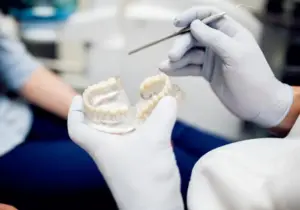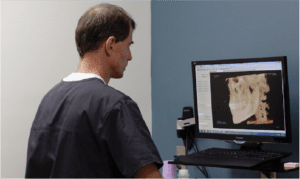Dental implants (artificial tooth roots permanently embedded in the jawbone with a false tooth attached) have an interesting history. Wood, copper, iron, gold, jade, platinum, porcelain, sea shells, and animal and human teeth were all tried — without much success — before an orthopedic surgeon found a material that would fuse well with human bone.
As far back as 2,000 BCE, the Chinese used carved bamboo pegs to replace missing teeth. The body of an Egyptian king from 1,000 BCE had a copper peg in his upper jawbone. Another archaeological, in France, dig uncovered a body from 300 CE with an implant made of iron.
It was common in ancient times for missing teeth to be replaced with teeth from animals or other people. Jade and seashells have also been found in ancient skulls. In the 18th century CE, researchers experimented with gold, alloys and a porcelain crown on a platinum disc.
The Problem: Fusion
The problem with all these materials was rejection of the material replacing the tooth root. In order for an implant to be successful, the replacement root and surrounding bone need to grow together through a process called osseointegration.
Finally, in 1952, an orthopedic surgeon found the answer. Doing a study on bone healing, he was able to get a titanium cylinder to fuse with a rabbit femur. The first titanium dental implant was placed in the jaw of a human volunteer in 1965.
The success of this implant led to other improvements. The next generation of implants was a titanium alloy screw with a rough surface that hastened osseointegration. The screw was inserted where the tooth should be, and after a period of healing, a crown was added over the screw.
The technology then further evolved to include a screw, an abutment (to connect the screw to the crown) and a ceramic crown, or false teeth. This system provides a very stable implant that looks and feels like a real tooth.
Today, dental implants are our best solution, not only for missing teeth, but also for unstable dentures, speech/smile/eating problems caused by dentures, lack of back teeth on which to attach a bridge, and the hassle of taking care of dentures. Oral surgeons have a long-term success rate of 95 to 97%.
Implants are often our preferred alternative to dentures and bridges because:
- They restore your smile and ability to speak and eat normally,
- preserve your bone and facial structure,
- prevent adjacent teeth from shifting (which can alter your bite), and
- are as easy to maintain as natural teeth.
Because implants last longer than dentures and bridges (25+ years compared to 5-15 years), they are often not more expensive than these less permanent alternatives in the long run.
Implant technology keeps improving, simplifying the surgery, shortening healing times, reducing complications, and providing better, more predictable results. Once the implant site has healed, most of our patients forget they even have implants!
The latest implant technologies are making it easier than ever to place implants—often in one treatment visit to Wilmington Oral Surgery.
After over a decade of improving patient smiles and oral health with implants, the procedure is routine for our team.









